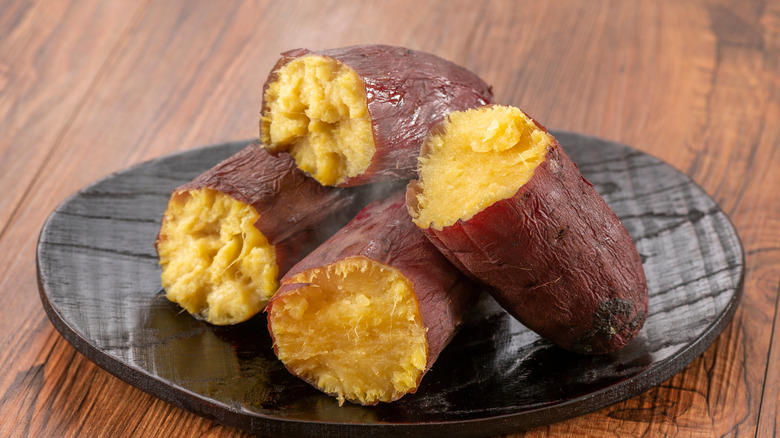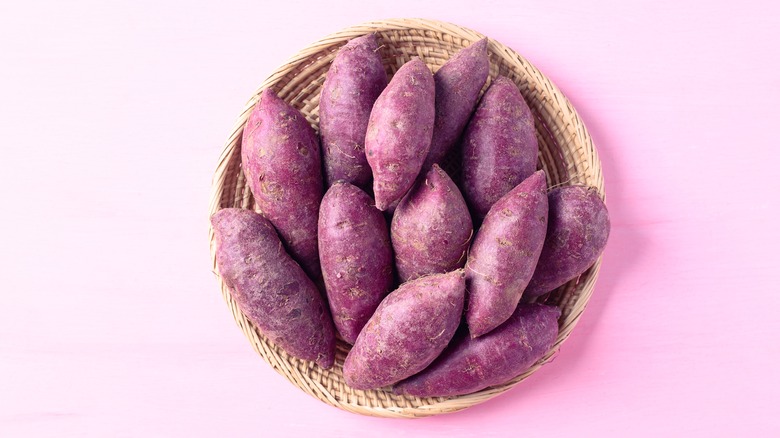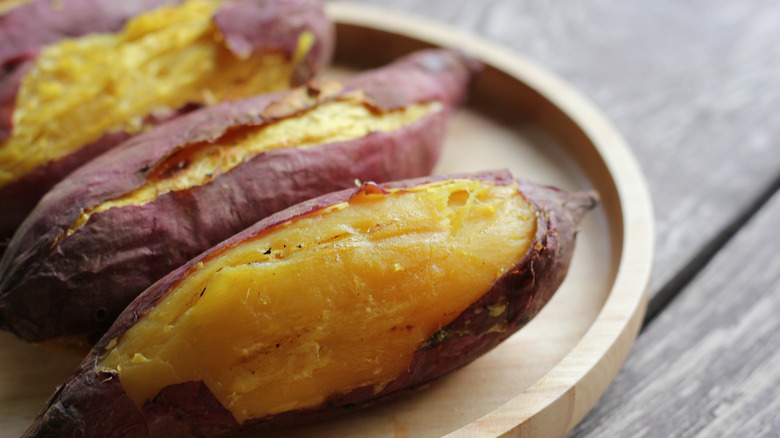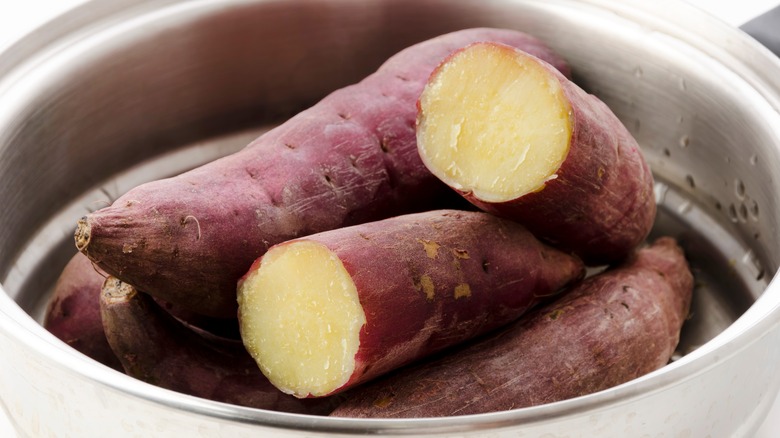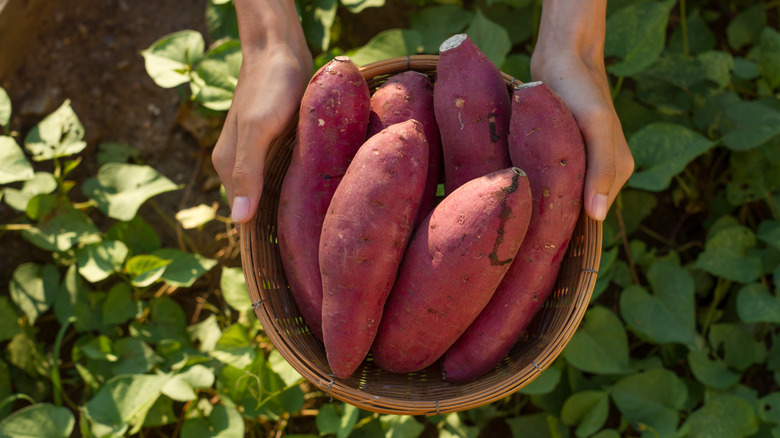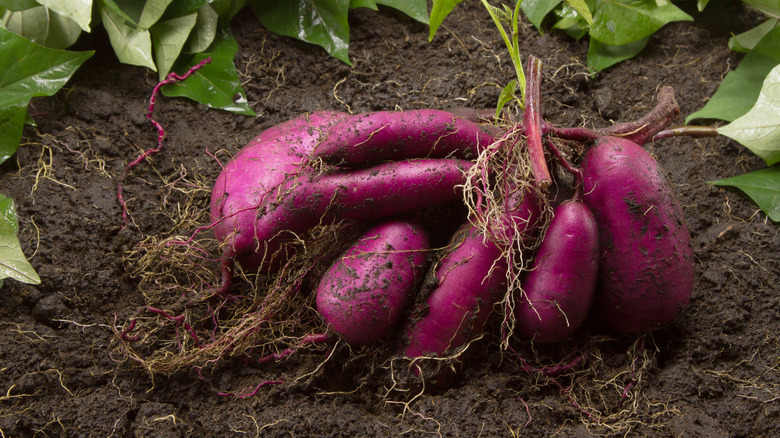Murasaki Sweet Potatoes Are On A Whole New Level Of Tenderness
Ah, sweet potatoes. They're arguably one of the most versatile vegetables out there, and you'll be hard-pressed to find anyone who doesn't love them. From crispy fries or a creamy mash, to well-seasoned roasted vegetables or greasy hash browns, there's no bad way to enjoy this staple food. And while they often get overlooked for their starchier, less-sugary (and unrelated) counterpart the standard potato, we're here to advocate for the former ingredient.
Sweet potatoes are a colorful and great-tasting option to mix up your typical dinner classics. Whether you're making oven-baked sweet potato fries or dicing them up for a creative take on a potato salad, it's both an easy and rewarding experience to make dishes with this mouthwatering ingredient. However, before you reach for your go-to sweet potato at the grocery store, we recommend trying out a unique variety from Japan called Murasaki (Ipomoea batatas 'Murasaki'). Also known simply as a Japanese sweet potato, it does not possess the typical characteristics you're familiar with. Instead, it displays a creamy white flesh rather than the classic orange hue, and it has a taste all its own. So, whether you're looking to mix up your healthy snack routine or you'd never intentionally skip trying a new food once presented (for science, of course), there's lots to learn about the tasty Murasaki variety.
What are Murasaki sweet potatoes?
Murasaki sweet potatoes originally come from Asia, but have since been cultivated to grow all over the globe. This variety has especially grown popular in North America, making it easier to find at your local supermarkets. When envisioning your favorite sweet potato variety, whether it's a garnet or jewel, you'll likely think of the bright orange colored flesh and brown skin that the vegetable is known for. The Murasaki sweet potato has less in common with these other types of than you might think. This Japanese variety is identifiable by its dark purple skin and white or golden colored flesh. It's also smaller in size than other sweet potatoes and a bit more rounded on the ends.
While these visual characteristics note clear differences between this vegetable and others like it, the taste of a Murasaki sweet potato is also unique and may possibly make it the most delicious variety of sweet potato that you've ever tried. Furthermore, these sweet potatoes are less moist than other varieties and have a higher starch content, making them ideal for certain cooking techniques.
What do Murasaki sweet potatoes taste like?
Like other sweet potatoes, this variety has the same sugary taste that is synonymous with the vegetable, but the sweetness in a Murasaki sweet potato is much stronger than some other varieties out there. Other underlying flavors in this vegetable include a rich earthiness and savory nuttiness, which add a layer of depth to its flavor profile. Specifically, the Murasaki sweet potato is often pointed to for its chestnut-like taste. It is known for having some slight floral notes, as well. Overall, Murasaki sweet potatoes have such a delicious flavor that they can easily be eaten on their own with a simple pat of butter.
The layered flavor profile of this vegetable pairs best with salty and naturally savory ingredients that balance out the sweet taste, so it can be used as a side to a basic meat and vegetables dish or featured in a more complex stew. No matter your preferences, there are lots of great ways to prepare and cook with this ingredient.
How to cook with Murasaki sweet potatoes
Murasaki sweet potatoes are just as versatile as every other type out there. They can be roasted, mashed, fried, boiled, or mixed into plenty of your favorite recipes as a creamy substitute ingredient. Their heartier nature particularly makes them ideal for roasting and baking.
These sweet potatoes are simple to cook with. Their skin can be left on, as it crisps up nicely and adds a satisfying crunch to the final result. One delicious way to enjoy them is to toss chopped cubes or wedges in light oil, sprinkle them with simple seasonings, and slide them into the oven to roast. When prepared in this way, they keep their sturdier texture, yet also take on a sweet and creamy quality. This dynamic is quite enjoyable to eat on its own or mixed into a meal.
Murasaki sweet potatoes make a perfect side dish to enjoy alongside a nicely prepared cut of meat, whether it's a juicy piece of chicken breast or a smothered steak. Alternatively, if you're all about layered textures and mixing flavors, add them to your favorite soups, salads, or curries for a truly elevated meal.
Where to buy Murasaki sweet potatoes
As mentioned, Murasaki sweet potatoes originated in Asia, however, their popularity has since skyrocketed in other parts of the world, including the United States. Today, they are grown in many states, including Georgia, Mississippi, Alabama, and California. If you're located near any of these states, you may be lucky enough to find some Murasaki sweet potatoes fresh from a local farmers market. If they're not available there, you may be able to locate them at a regular big-box grocery store, such as Walmart or Trader Joe's, or a specialty grocery store that tends to have a wide selection of lesser-known produce.
These veggies are in season toward the later part of summer and into early winter, but you shouldn't have a problem finding them at other times of the year. When selecting fresh Murasaki sweet potatoes, make sure they are firm to the touch and have evenly colored and textured skin. If it is overly squishy or has roots shooting out, it's passed its prime, and is not ideal to eat. That said, a ready-to-eat Murasaki sweet potato is a superb addition to your regular diet.
Nutritional information about Murasaki sweet potatoes
Any sweet potato you pick up from the grocery store is going to be packed with essential nutrients. While typical cooking methods involving lots of oil may bring down the overall healthiness of a sweet potato, the vegetable on its own is quite good for you. And, the Murasaki cultivar is no exception.
The sugary-tasting sweet potato may seem a bit deceptive. Its naturally honeyed taste might lead you to believe that it's not good for you, yet this couldn't be further from the truth. Murasakis are rich in vitamins, particularly vitamin A and C. Good-for-you minerals present in these veggies include potassium, calcium, iron, and plenty of fiber. They're also great sources of antioxidants.
If you want to take advantage of the most amount of nutrients available to you in this ingredient, make sure to stick to lighter cooking methods. Opt to roast or boil your sweet potatoes rather than deep fry them with fatty oils. However, we're positive no matter how you best enjoy cooking up this unique ingredient, you won't go back to other sweet potato varieties for a long while.
